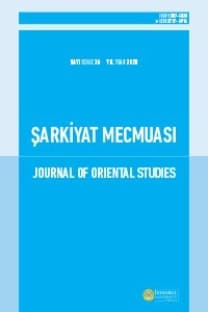Kıtan Dilinde Yazılmış Materyallere Genel Bakış
Uzun süre önce ortadan kalkmış olan Kıtan halkı orta çağda Doğu Asya ve Orta Asya’da önemli bir topluluktu. Liao Hanedanı ve Kara Hıtay devletini kurmalarına karşın dilleri ve yazıları Moğol fetihleri sonrasında büyük oranda Moğolların arasında asimile olmaları sonucunda unutulmuştur. Aslına bakılırsa Yelü Chucai belki de döneminin en ünlü Kıtanı idi, ve çağdaş dönemde de Yelü Chucai üzerine araştırmalar neredeyse Liao Hanedanının kurucusu olan Abaoji’yi geçmektedir. Yelü Chucai çağdaşı olan Moğol, Çinli ve Kıtanlar ve de günümüz tarihçileri tarafından büyük bir aydın olarak görülmektedir. Ancak bu makale bir Kıtan’ın bu dönemde Çinli, İranlı, ya da Orta Asyalı meslektaşlarından entelektüel olarak çok farklı olmadığını ve bir yüzyıldan daha uzun süredir gelişen Kıtan yazı geleneğinin bu durumun nedeni olduğunu gözler önüne sermeyi amaçlamaktadır. Bu çalışma Kıtan dilinde yazılmış olan edebiyat geleneğinin gelişimini incelemektedir ve Cengiz Kağan tarafından “urtuk sakal” olarak adlandırılan Yelü Chucai dönemine gelindiğinde Kıtanların artık son derece gelişmiş bir yazın geleneğine sahip olduğunu ve Yelü Chucai’yın bir istisnadan çok bir norm olduğunu göz önüne sermeyi amaçlamaktadır. Bu çalışmada Kıtan yazınına olan yaklaşım dilbilim temelli olarak değil metinlerin yazıldığı dönem göz önüne alınarak dönemsel olarak bölümlere ayrılmıştır. Kıtan dilindeki unvan ve sözcükler Kıtan karakterleri ile aktarım mümkün olmadığından Latin alfabesi ile aktarılmıştır.
Anahtar Kelimeler:
Kıtanlar, Kıtan Yazısı, Liao Hanedanı, Kıtan Dili, Kıtan Tarihi
A Review of Khitan Language Materials
The Khitan people, who have now disappeared for a long time, were an important group during the medieval period in East and Central Asia. Despite having established the Liao Dynasty and the Qara Khitai states, their language and script were forgotten following the Mongol conquests and they were largely assimilated by the Mongols. As a matter of fact, Yelü Chucai was perhaps the most famous Khitan of his time, and in modern times, studies on Yelü Chucai surpass those on Abaoji, the founder of the Liao dynasty. He has been presented as a great intellectual by his Chinese, Mongol and Khitan contemporaries as well as modern historians. However, this article aims to demonstrate that there was nothing extraordinary about a Khitan being on par with his Han Chinese, Persian or Central Asian counterparts intellectually by the time of Chucai, and his success was a culmination of over a century of Khitan tradition in both Khitan and Chinese. This study introduces and examines the development of the written tradition in the Khitan language and aims to demonstrate that Yelü Chucai was not an exception, but rather the norm by the time of Jinggis Qaghan, who called him “urtuq saqal”. The approach to Khitan literature was divided along historical period lines rather than linguistic lines. The Khitan words and titles have been written in Latin letters, since it was not possible to write them in either Khitan scripts. Keywords: Khitans, Khitan Intellectuals
Keywords:
Khitans, Khitan Intellectuals, Khitan Literature, Khitan Language, Liao Dynasty,
___
- Atik, Kubilay. “Ortaçağ Bozkır Devletlerinde Hayvancılık Üzerine Yasalar: Tangut Devleti Örneği.” Erzincan Üniversitesi Sosyal Bilimler Enstitüsü Dergisi 13, no. 2 (2020): 183–98. https://doi.org/10.46790/erzisosbil.798191.
- Atik, Kubilay. “A Comparison of Komnenos Era Byzantine and Song Era Chinese Diplomacy with Nomadic Neighbors.” Atatürk Üniversitesi Türkiyat Araştırmaları Enstitüsü Dergisi 70, no. 1 (2021): 343–58. http://www.turkiyatjournal.com/DergiTamDetay.aspx?ID=4433.
- Barfield, Thomas. The Perilous Frontier: Nomadic Empires and China, 221 BC to AD 1757. New York: Wiley, 1992.
- Ivliev, Alexander Lvovich. “Соотношение Культур Империи Ляо и Киданей [Sootnosheniye Kul’tur Imperii Lyao i Kidaney].” Археология и Этнография Народов Дальнего Востока. Сборник Научных Трудов. Владивосток [Arkheologiya i Etnografiya Narodov Dal’nego Vostoka. Sbornik Nauchnykh Trudov. Vladivostok], 1984.
- Kane, Daniel. The Kitan Language and Script. Vol. 166. Leiden: Brill, 2009.
- Shimunek, Andrew E. Towards a Reconstruction of the Kitan Language, with Notes on Northern Late Middle Chinese Phonology. Bloomington: Indiana University, Department of Linguisitcs and the Department of Central Eurasian Studies, 2007.
- Skaff, Jonathan Karam. “Barbarians at the Gates? The Tang Frontier Military and the An Lushan Rebellion.” War & Society 18, no. 2 (2000): 23–35. http://www.maneyonline.com/doi/abs/10.1179/072924700791201658.
- Standen, Naomi. Unbounded Loyalty: Frontier Crossings in Liao China. Honolulu: University of Hawaii Press, 2007.
- Tao, Zongyi. “輟耕錄 [Chuo Genglu].” Accessed January 10, 2021. https://zh.wikisource.org/zh-hans/%E8%BC%9F%E8%80%95%E9%8C%84.
- Vovin, Alexander. “Did the Xiongnu Speak a Yeniseian Language.” Central Asiatic Journal 44, no. 1 (2000): 87–104.
- Wittfogel, Karl A., and Chia-Sheng Feng. History of Chinese Society: Liao, 907-1125. Transactions of the American Historical Society 36. Philadelphia: Lancaster Press, 1949.
- Wu, Yingzhe, and Juha Janhunen. New Materials on the Khitan Small Script A Critical Edition of Xiao Dilu and Yelü Xiangwen. Corpus Scriptorum Chitanorum 1. Kent: Global Oriental, 2010.
- Yunusoğlu, Mağrifet Kemal. Uygurca-Çince İdikut Sözlüğü. Istanbul: Türk Dil Kurumu Yayınları, 2012.
- Zaitsev, Vasiliy Petrovich. “Рукописная Книга Большого Киданьского Письма Из Коллекции Института Восточных Рукописей РАН [Rukopisnaya Kniga Bol’shogo Kidan’skogo Pis’ma Iz Kollektsii Instituta Vostochnykh Rukopisey RAN].” Письменные Памятники Востока [Pis’mennyye Pamyatniki Vostoka: Written Monuments of the Orient], no. 2 (2011): 15.
- Zaitsev, Vyacheslav Petrovich. “Идентификация Киданьского Исторического Сочинения В Составе Рукописной Книги-Кодекса Nova Н 176 Из Коллекции Ивр Ран И Сопутствующие Проблемы [Identifikatsiya Kidan’skogo Istoricheskogo Sochineniya V Sostave Rukopisnoy Knigi-Kodeksa Nova N 176 Iz Kollektsii Ivr Ran I Soputstvuyushchiye Problemy].” Acta Linguistica Petropolitana-Trudy Instituta Lingvisticheskikh Issledovaniy 11, no. 3 (2015): 167–208. http://www.academia.edu/download/40789881/zaytsev_2015.pdf.
- ISSN: 1307-5020
- Yayın Aralığı: Yılda 2 Sayı
- Başlangıç: 1956
- Yayıncı: İstanbul Üniversitesi Edebiyat Fakültesi Şarkiyat Araştırma Merkezi
Sayıdaki Diğer Makaleler
Fettâhî’nin Hosn u Dil (Hüsn ü Dil)’i İle Fuzûlî’nin Sıhhat ve Maraz’ının Mukayesesi
Kıtan Dilinde Yazılmış Materyallere Genel Bakış
İbrahim Nasrallah’ın Beyaz Atlar Zamanı Adlı Eserinde Tarih ve Roman
Yabancı Dil Olarak Çince Öğretiminde Dinleme Dersi Öğretimi Sanatı
İslâm’ın Altın Çağında Harezm’de Türkler ve Türk Dili
Mehmed Zihni Efendi’nin Eserlerinde Arapça Sözlükleri Kullanma Usulü
Endülüs’te Mozarap, Yahudi ve Aljamiado Yazını
Reisüzzâkirîn’in Sefernâmesi ve İstanbul’daki Şiîlerin Dinî Hayatı
